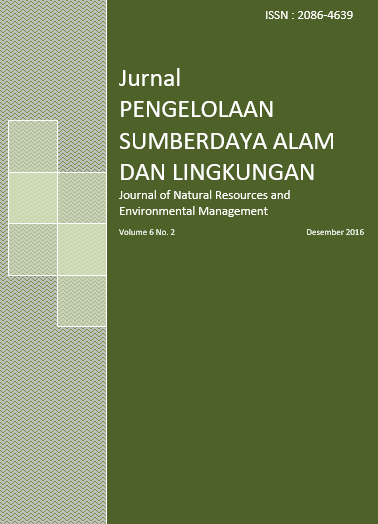ANALISIS NILAI KONSERVASI TINGGI ASPEK PENGENDALI EROSI DAN SEDIMENTASI (HCV 4.2) DI DAS CILIWUNG HULU
Abstract
Land use changes from forest to non forest on a large scale causing environmental damage and decrease the hydrologycal function of a watershed. The problem of forest change can be reduced by identifying, assessing and mapping of high coservation value areas based on requirements that led an area to be important outside the protected areas. This study was conducted at Ciliwung Upper Watershed. The aim of the research were identify the high conservation value areas base on environmental services aspect with erosion and sedimentation control (HCV 4.2), and b) analyze the consistency of HCV 4.2 to land capability class and Goverment Rule No 26 year 2008. The RUSLE equation to identify the area of HCV 4.2 is modified in HCV Toolkit that ignore the land management and conservation practice aspect. Land capability is classified base on Klingibel and Montgomary, but there are just 4 criteria which is used in this research (erosion, slope, depth of solum, and drainage). The result showed that 90% of total area of research was identified as area of HCV 4.2. There are 7 class of land capability (class I, II, III, IV, VI, VII and VIII) where the class IV and VIII are dominant in the area. From consistency analysis, it is known that 75% of area of HCV 4.2 is inconsistent with land capability class and Goverment Rule No 26 year 2008.
References
Arsyad, S, 2010. Konservasi Tanah dan Air. IPB Press, Bogor.
Hardjowigeno, Widiatmaka, 2007. Evaluasi Kesesuaian Lahan dan Perencanaan Tataguna Lahan. Gadjah Mada University Press, Yogyakarta.
[HCV Toolkit Indonesia] Konsorsium Revisi HCV Toolkit Indonesia. 2009. Panduan Identifikasi Kawasan Bernilai Konservasi Tinggi di Indonesia. Tropenbos International Indonesia Programme, Jakarta.
Kinnell, P.I.A. 2008. The Miscalculation of The USLE Topographic Factors in GIS. Faculty of Science University of Canberra. Canberra Australia.
[PP] Peraturan Pemerintah Nomor 26 tahun 2008 tentang Rencana Tata Ruang Wilayah Nasional. Sekretariat Negara, Jakarta. Tanggal 10 Maret 2008.
Qadariah, L., Arifjaya, N. M., Maryanto, I., 2004. Analisis curah hujan, erosi dan sedimentasi akibat perubahan tata guna lahan di sub DAS Ciliwung Hulu menggunakan simulasi answer. Dalam: Maryanto dan Ubaidillah, editor. Manajemen Bioregional Jabodetabek Profil dan Strategi Pengelolaan Sungai dan Aliran Air. LIPI: Pusat Penelitian Biologi. pp. 49-59.
Mario. 2016. Identifikasi HCVF. [terhubung berkala]. http://www.grahasentosa.com/index.php?option=com_content&view=article&id=47&Itemid=211. [ 29 Jan 2016].
Risdiyanto, I., Wibowo, A. D., Andri, N., Ganip, G., 2011. Konsep dasar HCV (High Conservation Value). [terhubung berkala]. http://banyumilih.blogspot.com/2011/03/kawasan-bernilai-konservasi-tinggi.html [ 20 April 2015].
Ruspendi D., 2014. Kajian perubahan penutupan lahan pada DAS Ciliwung Hulu dengan pendekatan spasial dinamik. Tesis. Sekolah Pascasarjana Institut Pertanian Bogor, Bogor
Sabar, 2004. Analisis alih fungsi lahan dengan menggunakan pengindraan jauh dan kesediaan membayar di sub DAS Ciliwung Hulu Jawa Barat Tesis Sekolah Pascasarjana Institut Pertanian Bogor, Bogor.
Sawijo. 2005. Manfaat pengembangan Dam parit untuk pengendalian banjir dan kekeringan. Study kasus Sub DAS Cibogo, DAS Ciliwung, Bogor. Bul. Balitklimat.
Sulistioadi, Y.B., Hussin, Y.A., Sharifi, A. 2010. Identification of high conservation value forest (HCVF) in natural production forest to support implementation of SFM certification in Indonesia using remote sensing and GIS. [terhubung berkala] http://www.isprs.org/proceedings/XXXV/congress/comm7/papers/32.pdf.
Suryadi, C. 2011. Wilayah prioritas konservasi tanah dan air di DA Ci Liwung Hulu. Tesis. Sekolah Pascasarjana Universitas Indonesia, Depok.
Taufik, K.L.Y., Wardianto, S., Haradi, Ubaidillah. 2004. Kualitas air hulu dan tengah sungai Ciliwung Kabupaten Bogor. Dalam: Maryanto dan Ubaidillah, editor. Manajemen bioregional jabodetabek profil dan strategi pengelolaan sungai dan aliran air. LIPI: Pusat Penelitian Biologi:181-221.
[UU] Undang-Undang Nomor 37 Tahun 2014 tentang Konservasi Tanah dan Air. Direktorat Jendral Bina Pengelolaan Daerah Aliran Sungai dan Perhutanan Sosial. Jakarta. Tanggal 17 Oktober 2014.
Authors
Authors who publish with this journal agree to the following terms:
- Authors retain copyright and grant the journal right of first publication with the work simultaneously licensed under a Creative Commons Attribution License that allows others to share the work with an acknowledgement of the work's authorship and initial publication in this journal.
- Authors are able to enter into separate, additional contractual arrangements for the non-exclusive distribution of the journal's published version of the work (e.g., post it to an institutional repository or publish it in a book), with an acknowledgement of its initial publication in this journal.
- Authors are permitted and encouraged to post their work online (e.g., in institutional repositories or on their website) prior to and during the submission process, as it can lead to productive exchanges, as well as earlier and greater citation of published work (See The Effect of Open Access).






